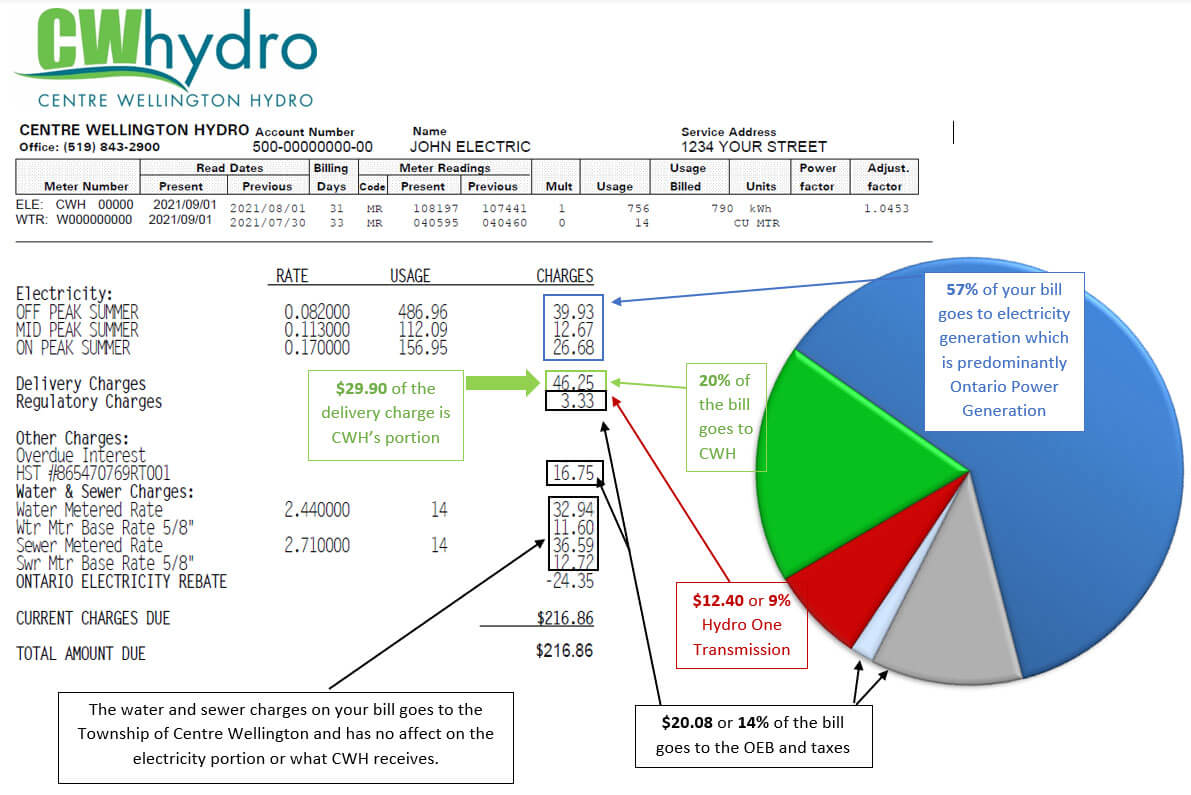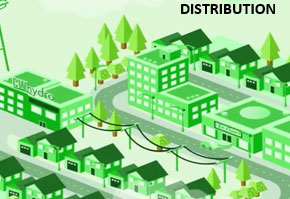Customer Engagement
This website is your opportunity to find out what CW Hydro’s plans are for major investments into our system, and how we prioritize through a Distribution System Plan.
What does Centre Wellington Hydro do?
 We own, operate, and maintain YOUR Distribution System that supplies you with electricity in the Town of Fergus and Village of Elora.
We own, operate, and maintain YOUR Distribution System that supplies you with electricity in the Town of Fergus and Village of Elora.
Our customer base consists of:
- 6,447 Residential Customers
- 778 Small Commercial Customers
- 59 Commercial Industrial Customers
- 7,351 Total customer count
The service territory is approximately 10 sq. km of high-density urban area, with customer density of approximately 680 per sq. km
Our Assets consist of:
- 6 Distribution stations
- 82 kms of overhead conductor
- 1,865 poles
- 892 overhead and underground transformers
- fleet of 8 vehicles
- Business office and service centre at 730 Gartshore St in Fergus
In 2020 our billing and customer service staff: Issued 87,012 bills ● Answered 4,943 calls ● Completed 1,564 underground locates ● Connected 218 new services.
We have a Full-Time staff of 15 employees and a Board of Directors with 4 independent members and 1 Municipal councillor. 20% of what you pay on your bill goes directly to CWH so we can perform all the functions required to operate your Utility.
Where does the money you pay on your bill go to?

How does the Distribution System work?

Ontario’s electricity system spreads throughout the province over what is called an electricity “grid”. The electricity grid’s overall components are broken out into three main sections: Generation, Transmission, and Distribution. All of these components work together to deliver the electrical needs to every customer in the province, from small residential and commercial to large industrial connections. The system is improved by grid technologies that support generation connections down to the distribution level.
All of these high-level sections are regulated by the Ontario Energy Board (OEB), who prescribes the requirements for Utilities to be licenced and operate within the province. The OEB also approves the electricity rates that are charged.
Generation
 Ontario has many sources of generation throughout the province. The bulk of Ontario’s generation comes from nuclear power and Hydro-electric stations, and the remainder comes from natural gas fired plants and renewable sources such as wind and solar.
Ontario has many sources of generation throughout the province. The bulk of Ontario’s generation comes from nuclear power and Hydro-electric stations, and the remainder comes from natural gas fired plants and renewable sources such as wind and solar.
Generation capacity connected by fuel type in 2020 |
Generation output by fuel type in 2020 |
 |
 |
Transmission
 The bulk electricity that is generated is then transmitted across the province along high voltage transmission tower corridors. Vast amounts of electricity can be delivered to both rural and city locations across the province to wherever the demand requires it. Hydro One is the Transmission company who owns and operates the transmission tower lines and transformer stations that deliver electricity to areas like Centre Wellington.
The bulk electricity that is generated is then transmitted across the province along high voltage transmission tower corridors. Vast amounts of electricity can be delivered to both rural and city locations across the province to wherever the demand requires it. Hydro One is the Transmission company who owns and operates the transmission tower lines and transformer stations that deliver electricity to areas like Centre Wellington.
Distribution Systems
 The final step in the grid electricity delivery is Distribution Systems. Centre Wellington Hydro (CWH) is your Local Distribution Company (LDC), and we are locally owned and operated by the Township of Centre Wellington and you, its residents. CWH lowers the voltage to safely connect to homes, business, and industries to meet every electrical need.
The final step in the grid electricity delivery is Distribution Systems. Centre Wellington Hydro (CWH) is your Local Distribution Company (LDC), and we are locally owned and operated by the Township of Centre Wellington and you, its residents. CWH lowers the voltage to safely connect to homes, business, and industries to meet every electrical need.
Operating the Distribution System to service our customers includes installing and maintaining pole lines, underground circuits, transformers, switches, and other equipment to ensure the safe, reliable delivery of electricity right to your home or business. We meter this electricity and monitor the system to ensure the settlement of electricity is fair.
What is a Distribution System Plan (DSP)?
 A DSP is a utility specific report that identifies the forecasted 5-year strategic programs CWH will use to maintain and replace its system as needed to provide the continuous, safe, reliable electrification to existing and new customers. All utilities must submit these plans to the Ontario Energy Board (OEB).
A DSP is a utility specific report that identifies the forecasted 5-year strategic programs CWH will use to maintain and replace its system as needed to provide the continuous, safe, reliable electrification to existing and new customers. All utilities must submit these plans to the Ontario Energy Board (OEB).
CWH’s investment planning shows the efficient budgeted costs to run the programs necessary to operate the distribution system, and replace and maintain our 6 distribution stations, 1,865 poles, 160 kms of overhead and underground circuits, 892 transformers, and 7,500 revenue meters.
CWH has fantastic outage and restoration statistics and proactively works towards maintaining the low outages our customers enjoy. To do this we need to run the programs that will keep our equipment running at optimal performance and replace assets in poor condition. You will see from the Asset Condition Assessment graph that 25% of our poles are in poor or very poor condition. Our main focus over the next 5 years will be replacing these poles.
Completing the survey will give you an opportunity to comment on CWH’s plans over the next 5 years.
Will the DSP affect my rates?
 Yes, the DSP will affect the rates set for the 2023 to 2027 timeframe, which the investment plan within the DSP covers.
Yes, the DSP will affect the rates set for the 2023 to 2027 timeframe, which the investment plan within the DSP covers.
Centre Wellington Hydro drafted its 2023 to 2027 DSP through a process that started with an Asset Condition Assessment (ACA) and inputs from engineering and technical experts. The fulsome review of CWH’s distribution system assets condition, and the technical decision to replace and maintain these assets at the targeted pace was tempered with our customers expectations, and rate impacts.
CWH’s strategy coincides with potential rate increases that are inline with inflation.
How will my engagement help?
CWH has completed a draft DSP that focuses on the condition of our assets and the capital and maintenance programs that we feel are required to keep the system up to date and reliable from a technical perspective.
By completing the survey, you have a say in what we are planning, which will help us understand the customer’s point of view and how they compare with our plans.
Your feedback from the survey will be used to make sure CWH’s plans align with our customers’ expectations and to finalize the DSP, taking into account your feedback.
Why participate in the survey? We want to know…
- Is CWH on the right track with its replacement and maintenance strategy?
- Should we be replacing aging assets more aggressively or allow them to fail?
- Are you willing to pay more on your electric bill to fund reduced outages and response times?
- Are we missing something that you feel is important?
Reliability is addressed within the DSP
 CWH’s reliability is better than the provincial average, meaning our customers have fewer outages, and when an outage occurs the time it takes to restore power is less. CWH accomplishes this through capital replacement programs and proactive maintenance programs that have been consistent over the last five years. The current DSP includes asset replacement and maintenance to the degree that reliability will remain the same and rates will increase only relative to inflation.
CWH’s reliability is better than the provincial average, meaning our customers have fewer outages, and when an outage occurs the time it takes to restore power is less. CWH accomplishes this through capital replacement programs and proactive maintenance programs that have been consistent over the last five years. The current DSP includes asset replacement and maintenance to the degree that reliability will remain the same and rates will increase only relative to inflation.
The 3 main contributing causes of outages in CWH’s area, other than scheduled maintenance are due to tree contact, adverse weather, and defective equipment.

CWH proactively trims trees to keep tree related outages low and plans to continue with the current 2-year trimming cycle. Regular trimming helps keep adverse weather outages to a minimum as high winds can cause tree uprooting and broken and falling limbs onto overhead lines, contributing to outages.
Keeping outages low requires replacing assets prior to failure while in service. Items such as poles, porcelain insulators and switches are replaced proactively, and this keeps reliability high and reduces the safety risk of failing while in service.
Some assets, such as transformers can be run to failure as it does not present a high safety risk and the cost to replace them is very high.
CWH balances this desire to maintain its current reliability performance with the costs associated with capital expenditures and maintenance programs.
Please complete the survey to let us know your thoughts on our approach to reliability.
CWH’s Scorecard
CWH’s outstanding performance on the measures in the OEB scorecard indicate no substantial additional material projects are required. CWH continues to strive to better serve the customer with the highest excellence. CWH’s intended action within the DSP is to maintain the performance of the historical averages, with capital budgets increasing relative to inflation of material and labour costs. When developing the DSP, CWH always considers its customers’ priorities and ensures that the investments it proposes will allow CWH to continue to serve customers as they expect. CWH will continue to invest in technology and our people, as needed, to ensure we continue to provide a high standard of service when responding to and resolving customer issues, as well as maintaining a high level of billing accuracy our customers can depend on.

The Customer Engagement Survey has now closed. Thanks to all who participated. The winners of the draw have been contacted directly to claim their prize.

Call Us
519-843-2900
Visit Us
730 Gartshore Street
Fergus, ON N1M 2W8
MAP

